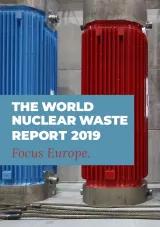Der World Nuclear Waste Report
Die Menge an Atommüll wächst weltweit. Aber auch 70 Jahre nach Beginn des Atomzeitalters hat kein Land der Welt eine echte Lösung für das strahlende Erbe der Atomkraft gefunden.
Die meisten Länder haben noch keinen konsistenten Ansatz für die Zwischen- und Endlagerung für alle Arten von Atommüll entwickelt und umgesetzt. Die Regierungen unterscheiden sich stark in ihren Strategien: bei der Suche nach einem Endlager, bei der Klassifizierung der strahlenden Abfälle, bei der Festlegung von Sicherheitsstandards, die von den Betreibern verlangt werden, und bei der Finanzierung der ständig steigenden Kosten all dessen.
Die Endlagerung von hochradioaktivem Atommüll stellt Regierungen weltweit vor große, bisher nicht ansatzweise gemeisterte Herausforderungen und birgt unkalkulierbare technische, logistische und finanzielle Risiken. Das stellt der erste „World Nuclear Waste Report – Focus Europe“ fest.
www.WorldNuclearWasteReport.org
Im Jahr 2020 wird der Bericht auf Französisch und Tschechisch veröffentlicht. Der Bericht steht unter einer Creative Commons License (CC-BY-NC-ND 3.0). Es können Texte und Abbildungen mit Angabe der Quellen verwendet werden.
Produktdetails
Inhaltsverzeichnis
Title page
Partners & Sponsors
Foreword
Acknowledgments
Key Insights
Executive summary
1. INTRODUCTION
2. ORIGINS AND CLASSIFICATION
2.1 Types of waste: the nuclear fuel chain
Uranium mining, milling, processing and fuel fabrication
Nuclear fission (fuel irradiation)
Management of spent fuel
Reactor (and fuel chain facility) decommissioning
2.2 Waste quantities and activity
2.3 Classification systems and categories
2.3.1 The IAEA classification
2.3.2 The EU classification
2.3.3 Examples of national classifications
2.4 Summary
3. QUANTITIES OF WASTE
3.1 Reporting obligations
3.2 Waste quantities along the supply chain
Uranium mining and fuel fabrication
Operational waste
Spent nuclear fuel
Decommissioning waste
Estimated waste quantities along the supply chain
3.3 Reported waste quantities under the Joint Convention
Uranium mining and fuel fabrication
Low- and intermediate-level waste
Spent nuclear fuel and high-level waste
3.4 Summary
4. RISKS FOR THE ENVIRONMENT AND HUMAN HEALTH
4.1 Radiation risks of nuclear waste
4.2 Risks from uranium mining, mine tailings, enrichment, and fuel fabrication
Health risks from exposures to uranium
Uranium mining
Uranium mine tailings
4.3 Risks from operation
Risks from gases, liquids and solid waste
Risks to nuclear workers
4.4 Risks from spent nuclear fuel
Risks of spent fuel in pools
4.5 Risks from the reprocessing of spent nuclear fuel
Fissile materials
Mixed oxide fuel (MOX)
4.6 Decommissioning risks
Continued radionuclide emissions from decommissioned reactors
Decommissioning vs operational exposures
4.7 Summary
5. WASTE MANAGEMENT CONCEPTS
5.1 Historical background
5.2 The context of nuclear waste management
5.3 Management concepts for nuclear waste
Disposal concepts
Host rocks
LILW-repositories
HLW-repositories
Deep borehole disposal
5.4 Interim strategies: storage
Interim storage
Extended storage
5.5 Summary
6. COSTS AND FINANCING
6.1 The nature of the funding systems for decommissioning, storage, and disposal
Basic liability for decommissioning and waste management
Overview and nature of the funds
Accumulation of the funds
6.2 Cost estimations and experiences
Cost estimation methodologies
Decommissioning costs
Disposal costs
6.3 Financing schemes
Financing schemes for decommissioning
Financing schemes for interim storage
Financing schemes for disposal
Integrated financing schemes
6.4 Summary
7. COUNTRY STUDIES
7.1 Czech Republic
Overview
Waste classification system
Quantities of waste
Waste management policies and facilities
Costs and financing
Summary
7.2 France
Overview
Waste classification system
Quantities of waste
Waste management policies and facilities
Costs and financing
Summary
7.3 Germany
Overview
Waste classification system
Quantities of waste
Waste management policies and facilities
Costs and financing
Summary
7.4 Hungary
Overview
Waste classification system
Quantities of waste
Waste management policies and facilities
Costs and financing
Summary
7.5 Sweden
Overview
Waste classification system
Quantities of waste
Waste management policies and facilities
Costs and financing
Summary
7.6 Switzerland
Overview
Waste classification system
Quantities of waste
Waste management policies and facilities
Costs and financing
Summary
7.7 The United Kingdom
Overview
Waste classification system
Quantities of waste
Waste management policies and facilities
Costs and financing
Summary
7.8 The United States of America
Overview
Waste classification system
Quantities of waste
Waste management policies and facilities
Costs and financing
Summary
8. TABLE OF ABBREVIATIONS
9. CONTRIBUTORS
Imprint
